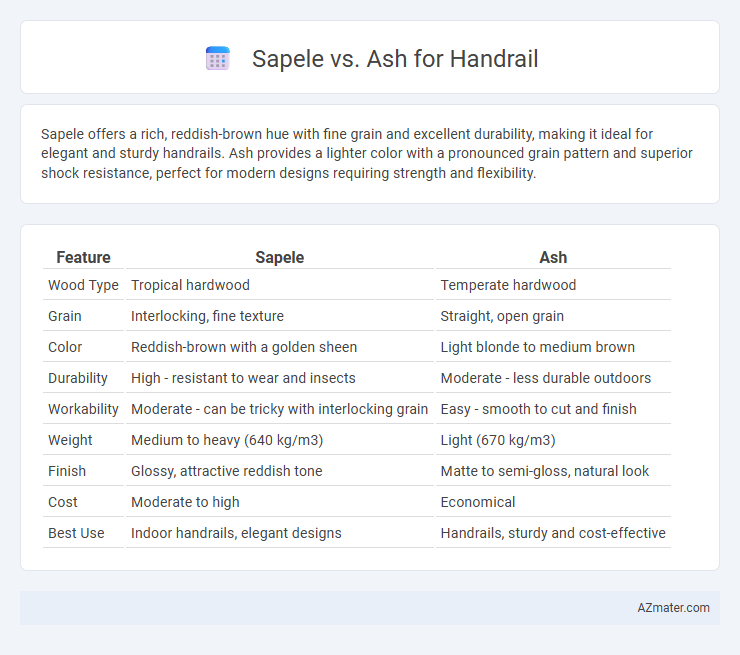Sapele offers a rich, reddish-brown hue with fine grain and excellent durability, making it ideal for elegant and sturdy handrails. Ash provides a lighter color with a pronounced grain pattern and superior shock resistance, perfect for modern designs requiring strength and flexibility.
Table of Comparison
| Feature | Sapele | Ash |
|---|---|---|
| Wood Type | Tropical hardwood | Temperate hardwood |
| Grain | Interlocking, fine texture | Straight, open grain |
| Color | Reddish-brown with a golden sheen | Light blonde to medium brown |
| Durability | High - resistant to wear and insects | Moderate - less durable outdoors |
| Workability | Moderate - can be tricky with interlocking grain | Easy - smooth to cut and finish |
| Weight | Medium to heavy (640 kg/m3) | Light (670 kg/m3) |
| Finish | Glossy, attractive reddish tone | Matte to semi-gloss, natural look |
| Cost | Moderate to high | Economical |
| Best Use | Indoor handrails, elegant designs | Handrails, sturdy and cost-effective |
Introduction to Sapele and Ash Wood
Sapele wood, derived from the African mahogany tree, is prized for its rich reddish-brown hue, fine grain, and durability, making it an excellent choice for handrails that demand both strength and aesthetic appeal. Ash wood, native to North America and Europe, features a light color with prominent grain patterns, offering superior shock resistance and flexibility ideal for handrail applications requiring robustness and a natural look. Both woods exhibit excellent workability and finish, but Sapele's higher density provides enhanced longevity, while Ash's elasticity delivers added resilience under stress.
Overview of Handrail Material Selection
Sapele handrails offer rich reddish-brown tones and excellent durability, making them ideal for both interior and exterior applications where aesthetic appeal and resistance to wear are important. Ash handrails provide a lighter, creamy color with exceptional strength and flexibility, suitable for high-traffic areas requiring sturdy yet visually subtle materials. Choosing between Sapele and Ash depends on desired color palette, structural demands, and maintenance preferences for the handrail installation.
Sapele Wood: Characteristics and Properties
Sapele wood, known for its rich reddish-brown hue and interlocking grain, offers exceptional durability and resistance to wear, making it ideal for handrails. Its natural density and hardness provide a smooth, splinter-resistant finish that enhances safety and longevity in high-traffic areas. Sapele's dimensional stability minimizes warping or swelling, ensuring a reliable and aesthetically pleasing handrail over time.
Ash Wood: Characteristics and Properties
Ash wood is renowned for its exceptional strength, durability, and elasticity, making it ideal for handrails that require both robustness and resilience. Its light color with straight grain patterns enhances aesthetic appeal, while its excellent shock resistance ensures long-lasting performance under frequent use. Compared to Sapele, Ash offers superior workability and a smoother finish, making it a preferred choice for custom, high-quality handrail installations.
Durability Comparison: Sapele vs Ash
Sapele offers superior durability for handrails due to its dense, interlocking grain that resists dents and scratches better than Ash. Ash, while strong and flexible, tends to be more prone to surface wear and requires regular maintenance to maintain its finish. The natural oils in Sapele enhance its resistance to moisture and decay, making it a longer-lasting choice for high-traffic handrail applications.
Aesthetic Differences: Color and Grain
Sapele offers a rich, reddish-brown hue with a striking interlocking grain pattern that creates a visually dynamic surface ideal for elegant handrails. Ash showcases a lighter, creamy color with a straight, pronounced grain, lending a clean and modern appearance perfect for contemporary interiors. The distinct color depth and grain complexity of Sapele contrast sharply with Ash's subtle and uniform texture, influencing the overall aesthetic impact of handrail installations.
Workability and Installation
Sapele offers excellent workability with its fine grain and uniform texture, allowing for smooth cutting and shaping, which simplifies handrail installation. Ash, known for its straight grain and high density, provides superior strength but can be somewhat harder to machine compared to Sapele, potentially increasing installation time. Both woods respond well to nails and adhesives, but Sapele's easier sanding and finishing properties make it a preferred choice for detailed handrail projects.
Maintenance and Longevity
Sapele wood offers moderate maintenance with its natural resistance to decay and insects, requiring periodic sealing to maintain durability in handrails. Ash, known for its strength and shock resistance, demands more frequent treatments against moisture and pests to prevent deterioration over time. Both woods provide longevity when properly maintained, but Ash typically requires more intensive upkeep to preserve its structural integrity in handrail applications.
Cost Analysis: Sapele vs Ash
Sapele is generally more expensive than ash due to its exotic origin and distinctive reddish-brown hue, making it a premium choice for handrails. Ash offers a more budget-friendly alternative with its lighter color and readily available source, often preferred for cost-conscious projects. When comparing longevity and maintenance, both woods perform well, but the initial cost difference shapes the overall investment in handrail installations.
Which Wood is Best for Handrails?
Sapele offers a rich reddish-brown hue with excellent durability and resistance to wear, making it a popular choice for handrails needing both elegance and strength. Ash wood is lighter in color with a straight grain and exceptional shock resistance, providing a sturdy and affordable option for high-traffic areas. Considering durability, aesthetic appeal, and maintenance, Sapele is best for luxury handrails, while Ash suits practical, budget-conscious projects.

Infographic: Sapele vs Ash for Handrail
 azmater.com
azmater.com